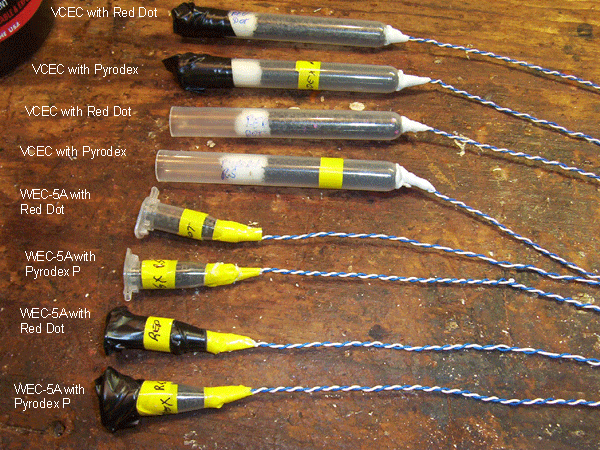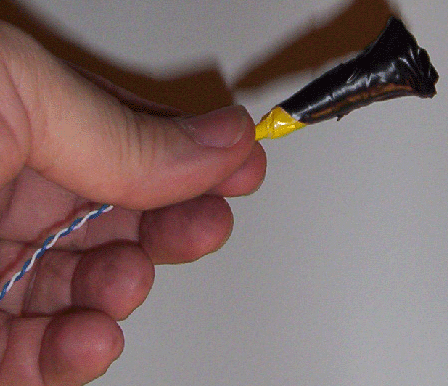
Rocket fliers have been using black powder (gunpowder) for ejection charges for many years. Because of increased restrictions on the sale and storage of black powder, we've had inquiries about whether or not "smokeless" powders could be used. There are also black powder substitute products like Pyrodex, designed for muzzleloading firearms but not subject to the same restrictions as standard black powder. However, many people reported that these alternatives didn't seem powerful enough to reliably eject a parachute. We decided to find out.
We prepared a test article that consisted of a fairly typical "main chute" compartment on a large rocket. The tubing is 4 inch diameter PML Quantum Tube, and the nose cone is a standard LOC Precision plastic cone. Inside there is a 50 inch Propulsion Polymers parachute, a large HeatShield Parachute Protector, and 10 feet of large Tubular Kevlar holding it all together. The TK extends out through the tube coupler and through the plywood bulkhead, and is epoxied in place. The tube coupler also has a 1 inch diameter PVC pipe fitting and cap, to make it easy to load various ejection charges into it.
We bought containers of Pyrodex RS, Pyrodex P, and Red Dot smokeless powders. All of them will fit into our different styles of Ejection Canister.
We prepared the following ejection charges to test:

We wanted to answer these questions:
|
Is it possible to substitute an alternative powder for black powder in an Ejection Canister? | |
|
Is there a difference between the various brands and grades of alternative powder? | |
|
Will the filament igniter in Ejection Canisters work with alternative powders? |
The results: (click the picture to display the MPG video)
| Reference shot: a standard Ejection Canister filled with 1.5 grams of black powder. | ||
| Pyrodex P in a standard with no containment. | ||
| Pyrodex P in a standard, similar to the one above but wrapped with three layers of electrical tape. | ||
| Pyrodex RS in an XL Variable Capacity Ejection Canister, three grams, with tape. Too much. |
We actually fired seven different combinations before we blew the back off the test article with three grams of Pyrodex RS in a taped XLEC canister. These video clips are the ones that best illustrate the results.
We learned that the filament igniters in Ejection Canisters will light alternative powders with no problem. Simply substituting an alternative powder for BP is inadequate. The alternative powder will not burn completely if it is not contained in some way; we frequently saw unburned powder inside the tube after firing an uncontained canister. Red Dot was the worst at this.
All you have to do to provide adequate containment is to wrap the Ejection Canister with two or three layers of electrical tape. We used a continuous piece of tape. We wrapped it twice across the opening of the Canister, then around the outside, completely covering the Canister down to the igniter.

This method works beautifully with standard snap-top Ejection Canisters. An un-taped VCEC with 3 grams of Pyrodex P managed to push the chute out of our test article, but we observed a lot of flame from late combustion and there was a lot of residue inside the tube. Taping the first inch of the VCEC definitely produces adequate containment for complete combustion. We found that out when a taped VCEC with 3 grams of Pyrodex RS blew the back off the test article.
In conclusion, we are confident that Pyrodex P can be used in our Ejection Canisters, as long as they are taped as described above. We'll add more information to this page when we get it. We want to publicly thank John Wickman and others who made suggestions that helped us perform these tests. Thanks, people!